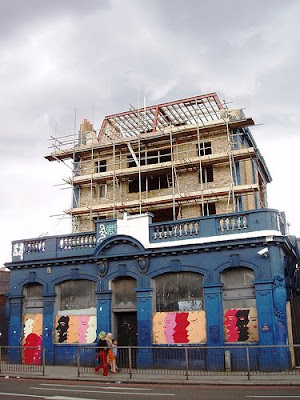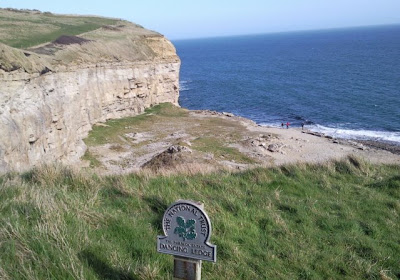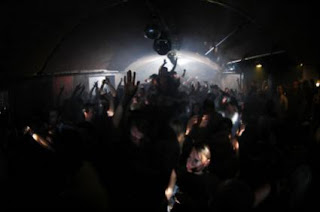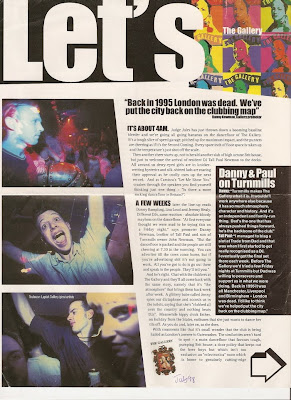Here's an interesting chapter in London dancing history - a dancehall in a groundbreaking health centre in South London. The Pioneer Health Centre in Peckham, South London (1935-50) has been seen by many as a precursor of the National Health Service. Some have argued though that it was in fact more radical than the NHS, including the anarchist Colin Ward who sadly died last month. He reviewed the main book about the Centre (Being Me and Also Us: Lessons from the Peckham Experiment by Allison Stallibrass) in New Statesman and Society, September 29th 1989, and indeed recalled his own visit there for a meeting of the London Anarchist Group. For him the Peckham Experiment was an exercise in mutual aid and self-help preferable to the top-down bureaucratic model of the NHS. The building still stand in St Marys Road, but has been converted to flats. Here's his review:Kenneth Clarke expostulated to a radio interviewer the other day: ‘We’ve never run the health service as some kind of workers’ cooperative.’ More’s the pity, I would say. But the real tragedy is that we have never run a health service, only an illness service. By stressing the word health, I don’t mean preventive medicine. I mean the pursuit of the conditions for personal, family and social well-being. There was one unforgettable experiment in this direction, and it died with the foundation of the NHS. This was the Pioneer Health Centre at Peckham.
For people like me, curious about the preconditions for resourcefulness and independence, it was a verification of our deepest convictions. The founders were a husband-and-wife pair of doctors, Innes Pearse and George Scoot Williamson. In 1938, they wrote about their Family Health Club: ‘It seems that ‘a sort of anarchy’ is the first condition in any experiment in human applied biology. This condition is also that to which our members most readily respond…’
It began much earlier, in 1926, when after welfare work in south London they concluded that most urban dwellers were so ‘de-vitalised’ that babies were born deficient in health. To study the characteristics of health they devised the idea of a family club, to be joined on two conditions, first, that the whole family must join; and second, that families must agree to a periodic medical examination.They started in a small house run as a club until 1929. The next step was to raise the money from charitable trusts to move to a purpose-built family club big enough to be self-supporting from subscriptions. By 1935 they had raised the cash and built the Pioneer Health Centre, designed by Sir Owen Williams. It was glass-walled inside and out, as the Peckham biologists needed to observe what members actually did. The centre of the building was a swimming pool, and there was a theatre, a gymnasium and a children’s nursery on the ground floor, with dance halls, a cafeteria, a library and medical rooms.
It ran from 1935 to 1939, and after the war from 1946 to 1950. It ended in 1951 after all efforts to get it adopted by local authorities or the NHS had failed. Since ‘health centres’ had become part of official doctrine after the National Health Service Act of 1946, the directors approached the Ministry of Health to incorporate it into official provision.
They failed for five reasons: first, it was concerned exclusively with the study and cultivation of health, not with the treatment of disease; second, it was based exclusively on the integrated family, not on the individual; third, it was based exclusively on a locality, it had no ‘open door’; fourth, its basis was contributory (2s 6d – 12 and a half pence – per family per week), not free; and fifth, it was based on autonomous administration, and so didn’t conform to the NHS structure.
The centre died but the idea did not. Pioneer Health Centre Ltd still exists and in the past ten years has ensured the republication by the Scottish Academic Press of all the old Peckham reports. The same publishers have just brought out, at £7.95, a new study called Being Me and Also Us: Lessons from the Peckham experiment. The author is Allison Stallibrass, a Peckham veteran and author of that modern classic of child development, The Self-Respecting Child.Her book is fascinating from several points of view. First, she has sought out people who were members as children or young parents and gathered their recollections of what the place meant in their lives. It is an enormously impressive testimony. Second, she shows how ahead of their time the Peckham pioneers were.
They were founder members of the Soil Association and took on a farm to ensure that members could buy nutritious bread, milk and vegetables and to provide holidays in the sun. Fifty years later, old Peckham hands remember that delicious bread. Third, she demonstrates how the preoccupation with the family was not a limiting, but an enlarging, factor. Members gradually accepted all the children as part of the family, while children and adolescents related to all the adults.Finally, she asks and ventures answers to the question: could we replicate the experiences of Peckham today? The original building cost about a fifth of the typical super-cinema of the period, though it was expensive to run. A modern equivalent would be far more useful in any community than the standard local ‘leisure centre’ which caters for a narrow band of the population and has no links with the ideology of self-catering, health-counselling, personal and social autonomy.
I only went there once, in 1949. I listened to Scott Williamson wittily addressing a meeting of the London Anarchist Group, and I visited Innes Pearse when she retired to Argos Hill windmill in Sussex. I never realised until I read this book that they must be considered as the truly creative figures in 20th century social medicine.

See also: Anarchism and the welfare state: the Peckham Health Centre by David Goodway:
'A different age group had caused mayhem on the opening of the new Centre in 1935, when the building was still uncompleted and much of the equipment intended for the children had still to arrive. Each day after school there was an invasion by crowds of kids, aged from seven to sixteen, who ran along the long open spaces and up and down the staircases, screaming, committing minor vandalism and making thorough nuisances of themselves. All the adults urged strong disciplinary measures - all except Williamson, who insisted that order would eventually be implemented by the children themselves as they responded to stimuli provided for them.
To this end [Lucy H.] Crocker was taken on the staff with the brief to resolve the problem. She was to discover that unsupervised children were excluded from the two places in the building, the swimming-pool and the gym, they found most appealing. Her solution was to develop a 'ticket system' whereby children could gain access to a preferred activity on obtaining a signed chit on each occasion from a member of staff cognisant of their physical abilities. This necessitated the children's continual interaction with an orderly, rational adult society and was found to foster responsibility, apparatus being returned to its designated place without request. 'The child is quick to respond to a mutually sustained order in society', as Pearse and Crocker were to put it. Within eighteen months of the reopening the screaming and running were no more and 'there were at last signs of order', Crocker recalled: 'not the quietness due to external discipline but the hum of active children going about their own business'.
This handling of the rowdy schoolchildren exemplifies the fifth condition on which the 'Peckham Experiment' depended: the maintenance of autonomy, autonomy not just for the adults but for their children also. Williamson and Pearse had no doubt that as biologists studying the human organism they had to deal 'with free agents', for 'any imposed action or activity becomes a study of authority, discipline or instruction...not the study of free agents plus their self-created environment'. In 1938, possibly foolhardily, they spoke warmly of 'a sort of anarchy', believing that 'a very strict "anarchy"...will permit the emergence of order through spontaneous action...' But although Williamson spoke to the London Anarchist Group on several occasions during the 1940s - chaired by John Hewetson, the GP editor of Freedom - he objected vehemently to the paper's coverage in 1951 of the announcement of the winding-up of the Centre (articles for which Colin Ward was primarily responsible), and which pointed to its anarchist, indeed revolutionary, nature. Williamson proclaimed: 'I am not an anarchist, nor do I believe in anarchy - not even the Kropotkin type'.
In truth, Williamson seems like A.S. Neill, the progressive educationalist, to have been an anarchist in both theory and practice, while denying he was one. Frances Donaldson (whose husband Jack was to manage the social floors in the Centre until they were running smoothly) had this to say about his remarkable disposition:
"...his lack of paternalismas far as this is humanly possible, was complete. He was not interested in how people should behave, or in how they might be made to behave, but only in how they did behave in any given circumstance...this made for a kind of democracy in the Centre which I doubt has ever been seen anywhere else...He had a rooted objection to the leader in society, regarding him as someone who pushed around the human material he wished to study in spontaneous action, and who exerted the force of his personality to drive more ordinary people out of the true of their natural behaviour into activities unsuited to them and which they half-consciously disliked. "
So while the 'health overhauls' enabled individuals to learn what they might be suffering from, the doctors did not direct them what to do, allowing them to make informed, autonomous choices. A visitor, who learned from Williamson that a man had 'a most dreadful hernia', asked why then had it not been treated and was told: 'It's his hernia. It's up to him when he wants to get it fixed up'. The condition of autonomy goes far to explain why the people of Peckham regarded the Centre as their own, filling the building with their autonomous activity. Clubs were formed and run by their members for a great range of pastimes, including camping, badminton, boxing, fencing and tap-dancing, while skills would be shared in, for example, dressmaking, woodwork, first aid and choral singing.'

The Pioneer Health Foundation site, which has lots more information, states that the polished cork tiles covering the floors were ideal for dancing, and that 'Amongst the many who made the most of it were the teenagers, freed at last from the streets, using the whole building intensively, exploring the whole community, and visibly thriving on it. The whole edifice used to rock on Saturday nights when the Long Room was packed with dancers, of all ages, dancing to the strains of the Centre's own band, directed by a most energetic member, a bookmaker by profession' (Jack Donaldson).
Photos from Pioneer Health Foundation - not sure when they were taken, I am guessing 1940s. Cross-posted from Transpontine on account of the dance content.
 Alabama 3 set the chemical country template with their debut Exile on Coldharbour Lane album in 1997 (Brixton's Coldharbour Lane is just round the corner from Brady's), and indeed their song Peace in the Valley gave the club it's name: 'she feels so twisted, she ain't never gonna fix it, she's just waiting for the light to shine on a brand new day'. Their genius was (and still is) to recognise that country's melancholic tales of addiction and redemption could speak to a generation coming down from ecstatic peaks.
Alabama 3 set the chemical country template with their debut Exile on Coldharbour Lane album in 1997 (Brixton's Coldharbour Lane is just round the corner from Brady's), and indeed their song Peace in the Valley gave the club it's name: 'she feels so twisted, she ain't never gonna fix it, she's just waiting for the light to shine on a brand new day'. Their genius was (and still is) to recognise that country's melancholic tales of addiction and redemption could speak to a generation coming down from ecstatic peaks.

 The Railway/Brady's closed down in 1999 and remained empty for many years later before briefly becoming a branch of Wahaca (full story at Urban 75 - from where the photo below was sourced)*. Along with the George Canning (now Hootananny), it was a place where drinking went on late into the Brixton night. The front bar in its Railway days was mostly frequented by older African Caribbean men, playing pool in front of murals of island scenes. The back bar was more Irish/squatters/SW9 itinerants - I remember being in there one night at a London Celtic Supporters Club social with a band called Athenrye banging our republican songs. There was also a band called the Dead B Specials who used to hang out there.
The Railway/Brady's closed down in 1999 and remained empty for many years later before briefly becoming a branch of Wahaca (full story at Urban 75 - from where the photo below was sourced)*. Along with the George Canning (now Hootananny), it was a place where drinking went on late into the Brixton night. The front bar in its Railway days was mostly frequented by older African Caribbean men, playing pool in front of murals of island scenes. The back bar was more Irish/squatters/SW9 itinerants - I remember being in there one night at a London Celtic Supporters Club social with a band called Athenrye banging our republican songs. There was also a band called the Dead B Specials who used to hang out there.



















 Club UK was the opposite of cool, in every sense of the word. It was a sweatbox with little or no air conditioning, condensation dripping off the ceilings and sometimes unbearably hot and crowded. One night when we there they had to open the fire exit into the Arndale to let people breathe - so there was an impromptu chill out area on a balcony overlooking the deserted shopping centre (pretty sure this was on their second birthday party, July 1st 1995, with Danny Rampling playing). I remember sucking ice pops to try and cool down. The place was ecstasy fuelled, so many people would go the whole night without buying a drink. Many dubious clubs at that time used to turn off the water in the bathrooms so that people had to buy water from the bar. I don't recall Club UK going to that extreme, but sometimes the cold water taps were reduced to a dribble and they certainly made a small fortune selling their own brand of bottled water. Like in many clubs, there were many random acts of kindness as strangers offered each other sips of water on the dancefloor.
Club UK was the opposite of cool, in every sense of the word. It was a sweatbox with little or no air conditioning, condensation dripping off the ceilings and sometimes unbearably hot and crowded. One night when we there they had to open the fire exit into the Arndale to let people breathe - so there was an impromptu chill out area on a balcony overlooking the deserted shopping centre (pretty sure this was on their second birthday party, July 1st 1995, with Danny Rampling playing). I remember sucking ice pops to try and cool down. The place was ecstasy fuelled, so many people would go the whole night without buying a drink. Many dubious clubs at that time used to turn off the water in the bathrooms so that people had to buy water from the bar. I don't recall Club UK going to that extreme, but sometimes the cold water taps were reduced to a dribble and they certainly made a small fortune selling their own brand of bottled water. Like in many clubs, there were many random acts of kindness as strangers offered each other sips of water on the dancefloor.



 Clubs open and close all the time, still
Clubs open and close all the time, still 





